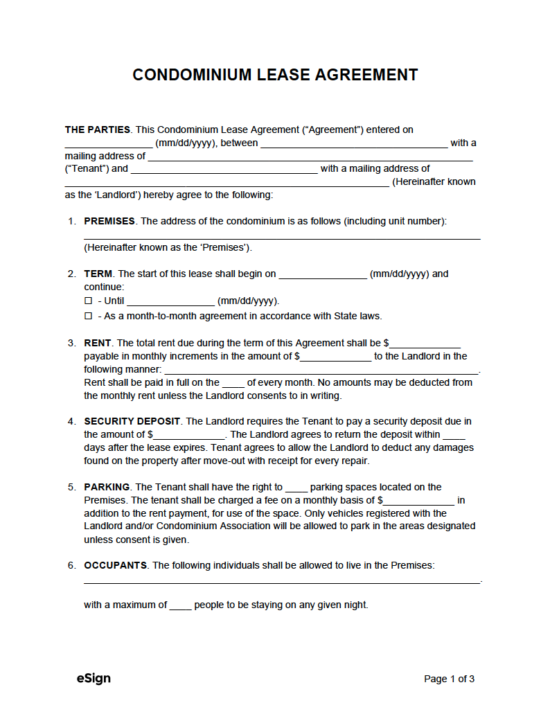
A condominium lease agreement is a rental contract between a landlord who agrees to rent a condo to a tenant for a fixed period. Unlike an apartment, there may be special rules enforced by the homeowner’s association (HOA) that are outside of the landlord’s control. This may include a separate tenant application process, age restrictions (no children), and prohibiting pets.
A condominium lease agreement is a rental contract between a landlord who agrees to rent a condo to a tenant for a fixed period. Unlike an apartment, there may be special rules enforced by the homeowner’s association (HOA) that are outside of the landlord’s control. This may include a separate tenant application process, age restrictions (no children), and prohibiting pets.
PDF Download
A condominium lease agreement is a rental contract between a landlord who agrees to rent a condo to a tenant for a fixed period. Unlike an apartment, there may be special rules enforced by the homeowner’s association (HOA) that are outside of the landlord’s control. This may include a separate tenant application process, age restrictions (no children), and prohibiting pets.
4.8 | 157 Ratings Downloads: 11,371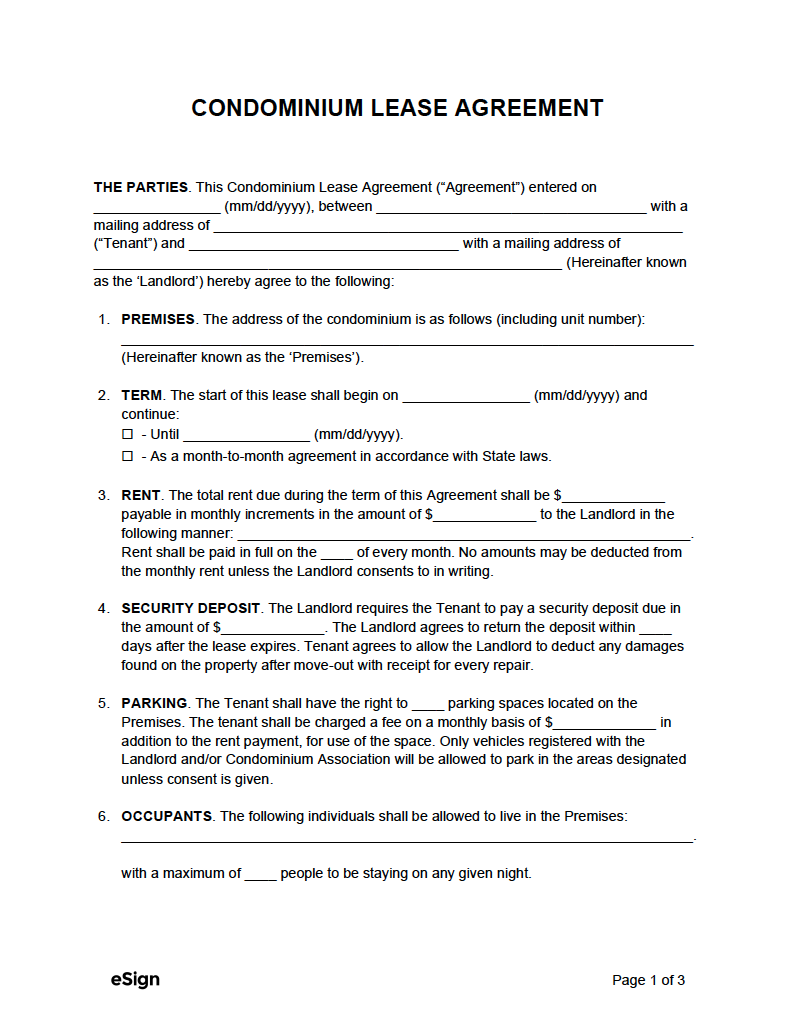
Rental Application – To screen a tenant by using the information provided in the form to look up their credit profile and criminal history.

The landlord should prepare the property for lease by making sure it’s in excellent condition. This may require calling professionals and hiring a cleaning company to conduct a “deep-clean” of the premises. This involves moving the furniture and scrubbing each nook and cranny of the space (use Thumbtack to find local cleaners).
In addition, the following should be cleaned or checked:
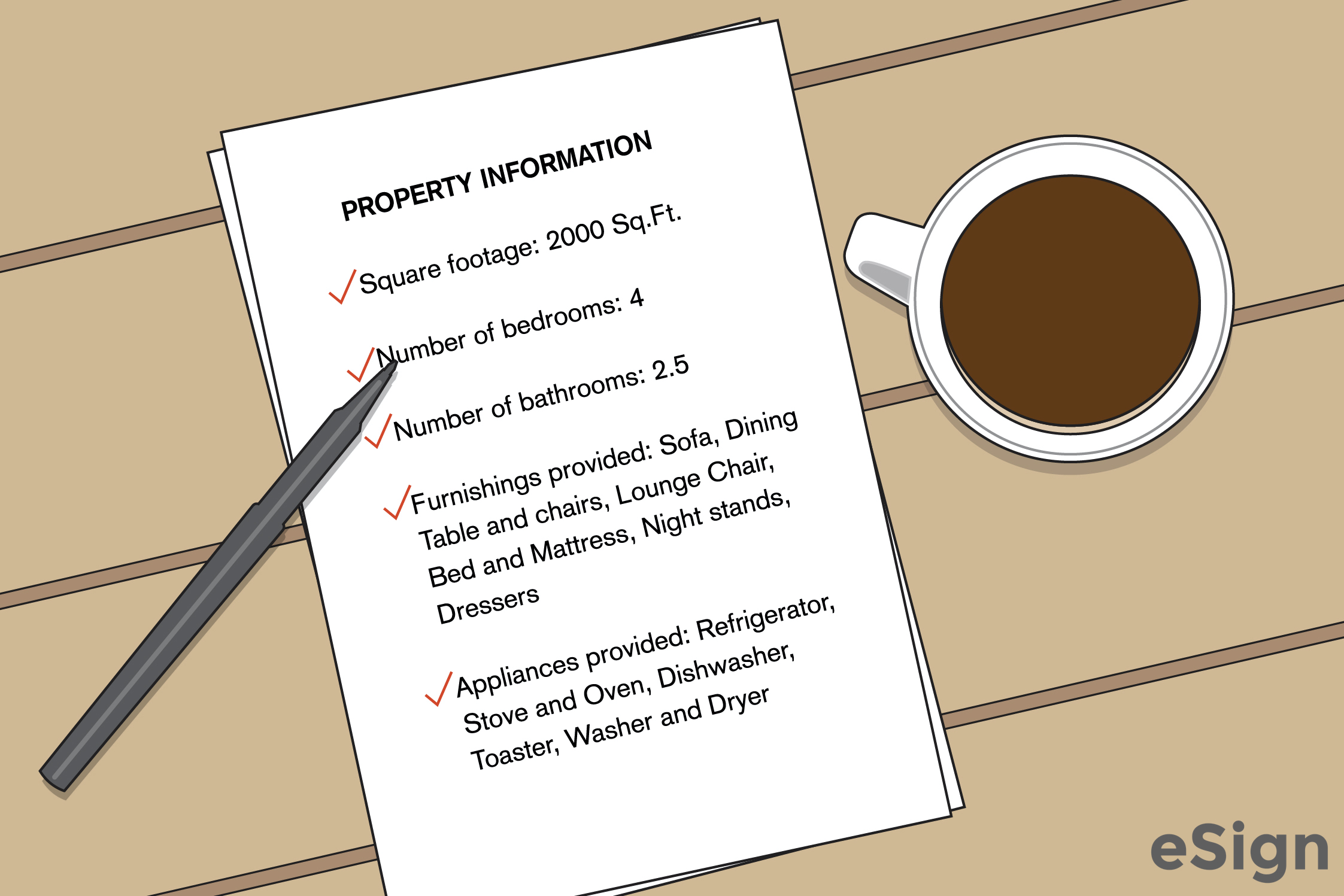
The landlord should gather all property information to provide as many details to the tenant as possible. At a minimum, this should include the following information:
In addition to gathering the property information, the landlord should obtain a copy of the association’s bylaws for prospective tenants to read prior to moving in. For example, there could be association rules about pets being a certain weight limit that the tenant should be made aware of.

With the information collected in step 2, the owner should create a listing for their condominium online. There are several platforms to choose from, and owners can decide to list on however many as they see fit. It’s arguably more important for the landlord to complete one (1) high-quality, detail-rich ad than several low-quality ads. A few popular options include Zillow, Facebook, Craigslist, and Apartments.com.

Any renters that show serious interest in signing a lease for the condo should be required to complete a rental application. Once the tenant completes the form, the landlord will go through it and look for anything that would suggest the tenant could be problematic. They should also conduct a background check to look for previous evictions, criminal history, credit issues, and more. The average background check will cost around $20. Popular background check providers include Experian, SmartMove, and RentPrep. Calling the references the tenant listed in the application is also recommended. Landlords cannot deny a tenant for anything protected by the Federal Fair Housing Act, which includes anything relating to the applicant’s race, disability, color, national origin, religion, familial status, or sex.
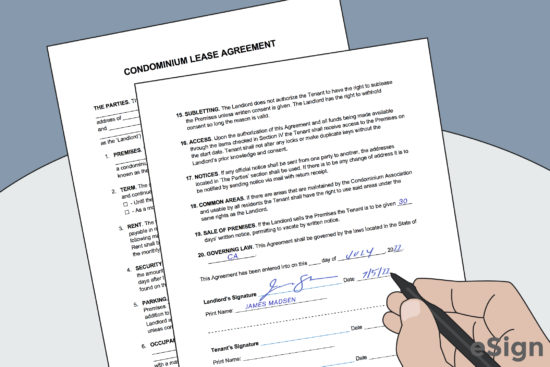
Once a tenant has been approved, a condominium lease agreement can be downloaded (PDF, Word (.docx), or OpenDocument) and completed. Complete all required fields and edit any fields to ensure the agreement is in-line with the condo association’s rules. Go over the entire agreement with the tenant and any other important property or condo association documents. The agreement will then need to be signed (by hand or using eSign) by the landlord and tenant. Guests of the tenant do not need to sign the lease. The owner should then perform the following tasks:
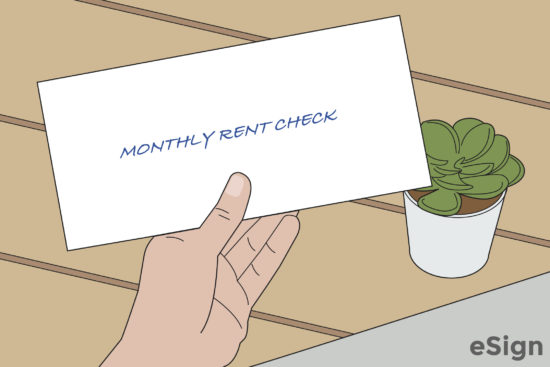
The landlord will need to collect rent on a monthly basis until the lease terminates. Additionally, they should monitor all expenses related to the condo, as these can be deducted later on. The owner should be reachable in the event the tenant needs to ask for repairs or help with any another issue. Upon termination of the agreement, the owner should go through the entire unit with a checklist to look for damage. As long as the tenant paid their rent on time and in full and left the rental damage free (apart from standard wear and tear), the owner should return the full security deposit to the tenant.
CONDOMINIUM LEASE AGREEMENT
1. THE PARTIES. This Condominium Lease Agreement (the “Agreement”) entered on [MM/DD/YYYY] , between [TENANT NAME(S)] with a mailing address of
[TENANT ADDRESS] (the “Tenant”) and [LANDLORD NAME] with a mailing address of [LANDLORD ADDRESS] (the “Landlord”), both hereby agree to the following:
2. PREMISES. The address of the condominium is as follows (including unit number): [CONDOMINIUM ADDRESS] (the “Premises”).
3. TERM. The start of this lease shall begin on [MM/DD/YYYY] and continue: (check one)
☐ – Until [MM/DD/YYYY] .
☐ – As a month-to-month agreement in accordance with State laws.
4. RENT. The total rent due during the term of this Agreement shall be $ [TOTAL RENT] payable in monthly increments in the amount of $ [MONTHLY RENT] to the Landlord in the following manner: [RENT PAYMENT METHOD(S)] .
Rent shall be paid in full on the [#] of every month. No amounts may be deducted from the monthly rent unless the Landlord consents to it in writing.
5. SECURITY DEPOSIT. The Landlord requires the Tenant to pay a security deposit due in the amount of $ [SECURITY DEPOSIT] . The Landlord agrees to return the deposit within [#] days after the lease expires. The Tenant agrees to allow the Landlord to deduct any damages found on the property after move-out with a receipt for every repair.
6. PARKING. The Tenant shall have the right to [#] parking spaces located on the Premises. The tenant shall be charged a fee on a monthly basis of $ [PARKING FEE] in addition to the rent payment for use of the space. Only vehicles registered with the Landlord and/or Condominium Association will be allowed to park in the areas designated unless consent is given.
7. OCCUPANTS. The following individuals shall be allowed to live in the Premises: [LIST ALL OCCUPANTS HERE] .
8. UTILITIES. The Landlord shall be responsible for providing the following: (check one)
☐ – Water
☐ – Electricity
☐ – Sewer
☐ – Cable
☐ – Internet
☐ – Heat
☐ – Trash Removal
☐ – Other [OTHER UTILITIES] .
In addition, the Landlord shall provide the following appliances: [LIST ALL APPLIANCES HERE] .
The Landlord agrees to keep the Premises in good condition and to repair any services temporarily interrupted. Any damage caused by nature or any wear and tear shall not affect the payment of rent by the Tenant as long as the Landlord is pursuant to State laws.
9. PETS. The Landlord: (check one)
☐ – Allows pets on the property with an additional fee of $ [PET FEE] .
☐ – Shall allow only a certain pet described as [PET TYPE(S)] with an additional fee of $ [PET FEE] .
☐ – Prohibits any type of pet on the Premises except for those used for special needs in accordance with State or Federal law.
10. USE. The Tenant shall only be able to use the Premises for residential purposes.
11. POSSESSION. The Tenant shall obtain possession of the Premises on the start date stated in Section 3. If not, the Tenant may seek damages from the Landlord. In addition, the Tenant is required to take possession of the Premises within seven (7) days or be in default of this Agreement and forfeit their Security Deposit with the Landlord.
12. CONDITION. The Tenant understands that they will be accepting the Premises in its “as is” condition. The Tenant acknowledges that they have conducted a thorough inspection and found it to be in good repair and condition for use as a residence.
13. ALTERATIONS. The Tenant shall maintain and keep in good condition all appliances, furnishings (if any), and personal property until the end period. If the Tenant damages any part of the Premises due to negligence, the Landlord may fix the issue and charge the Tenant additional rent. The Tenant shall not paint the Premises or make any modifications without the written consent of the Landlord.
14. LIABILITY. The Landlord is not liable for any loss or damage to the Tenant’s or their guests’ personal property unless the loss is a direct result of the Landlord’s action. The Tenant is liable for the acts of anyone listed in this Agreement in addition to any guest that they should allow on the Premises.
15. ENTRY. Per State law, the Landlord has the right to enter the property by giving the Tenant proper notice for any repair, inspection, extermination, installation, or any entry deemed necessary. The Landlord will have the right to show the Premises to prospective Lessees at the end of the Agreement’s term, with adequate notice being given prior to every entry.
16. SUBLETTING. The Landlord does not authorize the Tenant to have the right to sublease the Premises unless written consent is given. The Landlord has the right to withhold consent so long the reason is valid.
17. ACCESS. Upon the authorization of this Agreement and all funds being made available, the Tenant shall receive access to the Premises on the start date. The Tenant shall not alter any locks or make duplicate keys without the Landlord’s prior knowledge and consent.
18. NOTICES. If any official notice shall be sent from one party to another, the addresses located in Section 1 shall be used. If there is to be any change of address, it is to be notified by sending a notice via certified mail with return receipt.
19. COMMON AREAS. If there are areas that are maintained by the Condominium Association and usable by all residents the Tenant shall have the right to use said areas under the same rights as the Landlord.
20. SALE OF PREMISES. If the Landlord sells the Premises, the Tenant is to be given [#] days’ written notice, permitting to vacate by written notice.
21. GOVERNING LAW. This Agreement shall be governed by the laws located in the State of [STATE NAME] .
This Agreement has been entered into on [MM/DD/YYYY] .
Landlord’s Signature: ________________________ Date: [MM/DD/YYYY]
Print Name: [LANDLORD NAME]
Tenant’s Signature: ________________________ Date: [MM/DD/YYYY]
Print Name: [TENANT NAME]
Tenant’s Signature: ________________________ Date: [MM/DD/YYYY]
Print Name: [TENANT NAME]